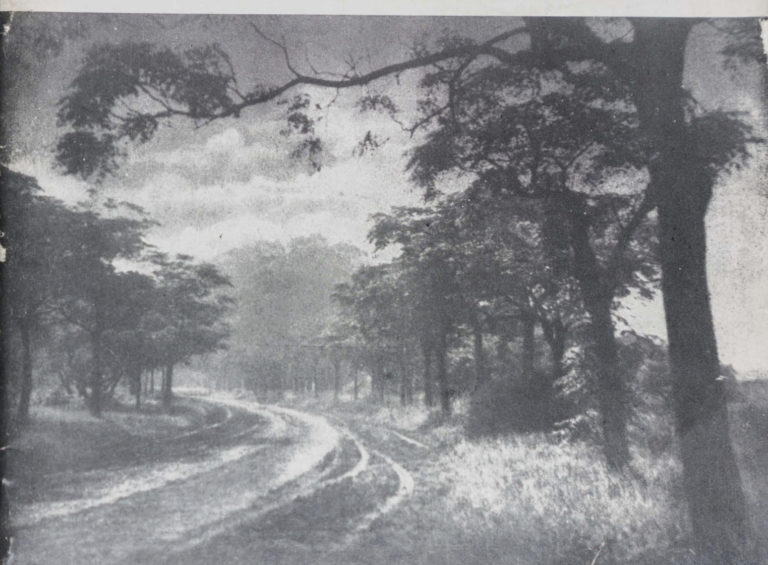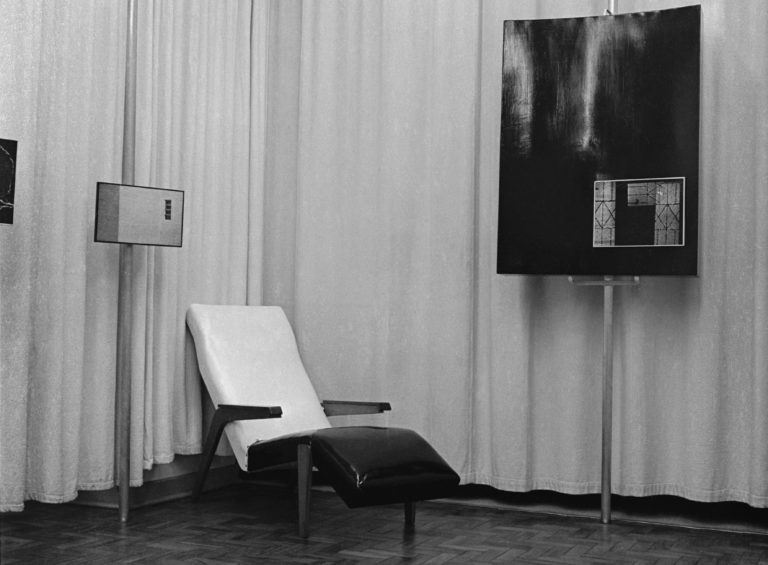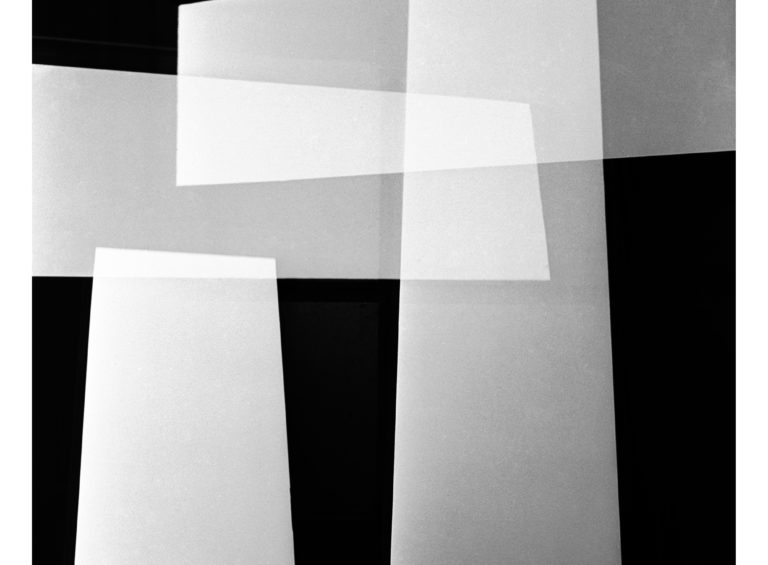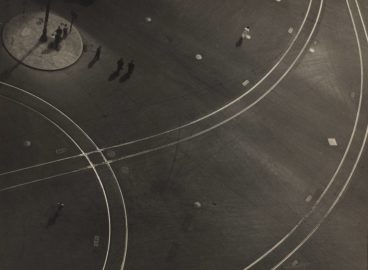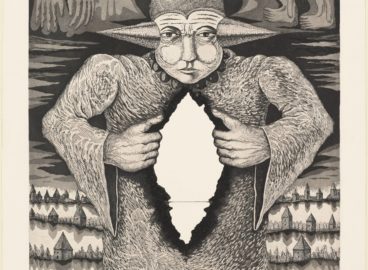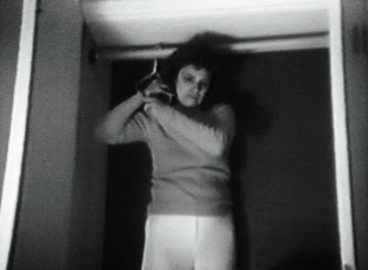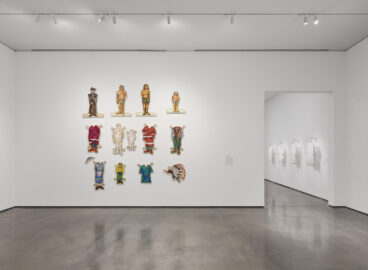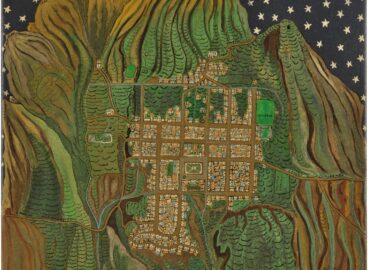This essay is the second in a series of texts on the Foto Cine Club Bandeirante, a group of amateur photographers whose ambitious and innovative works embodied the abundant originality of postwar Brazilian culture.1Heloisa Espada’s essay revisits content published on previous occasions, including, most importantly, Heloisa Espada, “Fotoformas: a máquina lúdica de Geraldo de Barros” (master’ thesis, Universidade de São Paulo with funding provided by the Fundação de Amparo à Pesquisa do Estado de São Paulo [FAPESP], 2007; and Heloisa Espada, ed., Geraldo de Barros e a Fotografia (São Paulo: Instituto Moreira Salles, 2014). The series coincides with the exhibition Fotoclubismo: Brazilian Modernist Photography, 1946–1964, on view at the Museum of Modern Art from May 8 to September 26, 2021.
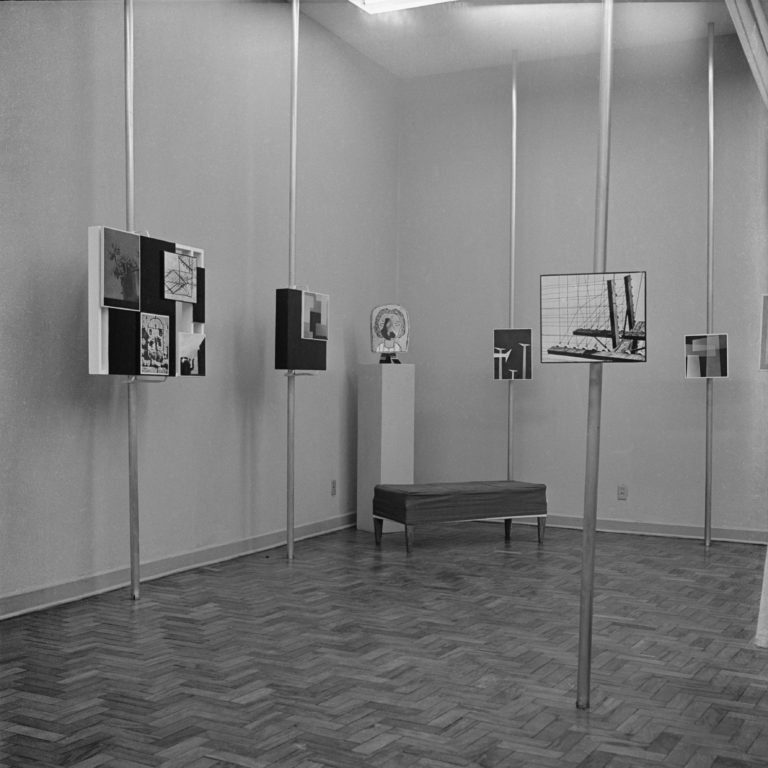
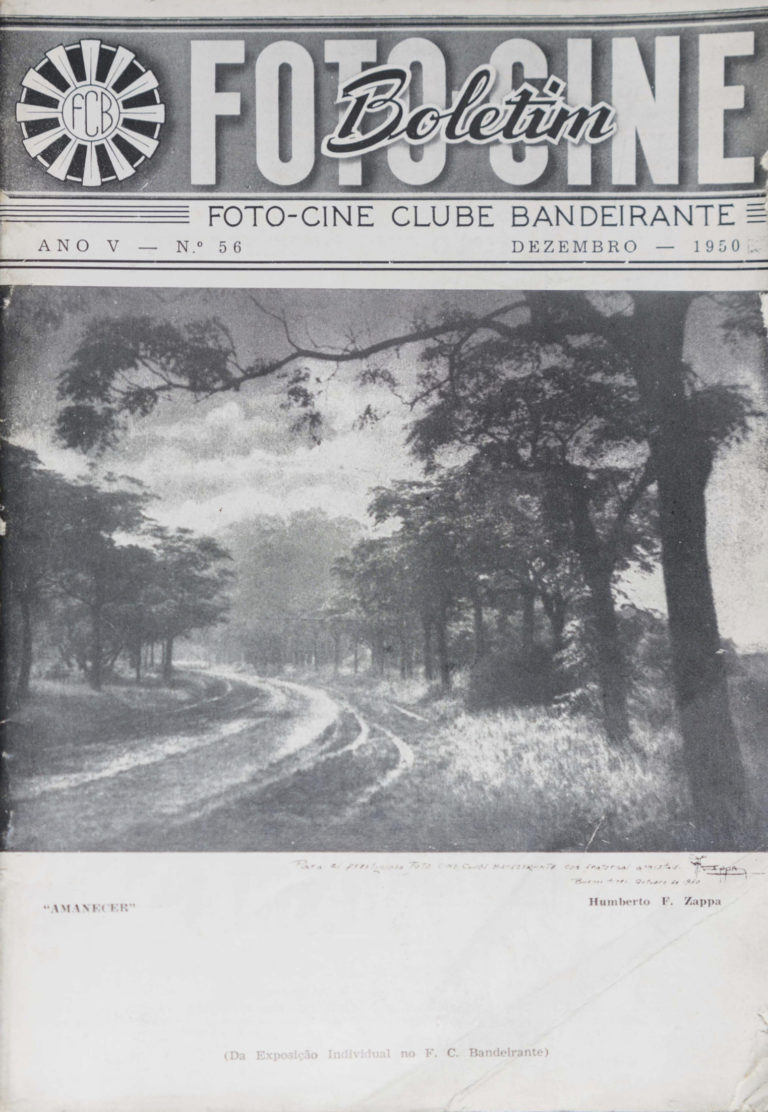
From January 2 to 18, 1951, while the Museu de Arte de São Paulo (MASP) was featuring the work of Geraldo de Barros (1923–1998) in a small temporary exhibition entitled Fotoforma, the Foto-Cine Clube Bandeirante (FCCB) was celebrating Argentinean pictorialist Humberto Zappa in its headquarters.2Argentinean amateur Humberto F. Zappa’s exhibition of forty-two bromoils opened on December 18, 1950. That month, the Boletim Foto Cine ran Zappa’s photo Amanhecer on its cover as well as his text “Apologia do bromólio” and a note on the exhibition inside. See: Boletim Foto Cine 56 (December 1950): 6–7, 14. Barros had joined the FCCB in May 1949, but his exhibition at one of the country’s most important museums was mentioned only briefly in the Boletim Foto Cine’s February 1951 “Note of the Month.” The Boletim, an official publication of the FCCB, regularly published news of photographic exhibitions throughout Brazil, especially those including its members. In fact, the magazine celebrated solo exhibitions of work by Thomaz Farkas (1924–2011) at the Museu de Arte Moderna de São Paulo (MAM/SP) in 1949,3“Exposição Thomaz J. Farkas,” Boletim Foto Cine 39 (July 1949): 14. German Lorca (1922-2021) at the same venue in 1952, Francisco Albuquerque (1917–2000) at MASP in 1952,4“Exposição G. Lorca,” Boletim Foto Cine 74 (July 1952): 30; “Exposição de Francisco Albuquerque ‘A jangada,’” Boletim Foto Cine 78 (1952): 24. and Ademar Manarini (1920–1989) at MAM in 1954.5“Exposição de Fotografias de Ademar Manarini,” Boletim Foto Cine 91 (August 1954): 13–16. It also publicized the special room devoted to photographs by FCCB members at the second edition of the Bienal de São Paulo.6Geraldo de Barros, “A sala de fotografia,” Boletim Foto Cine 87 (February 1954): 12–13. Although Fotoforma had been highlighted in the press by a number of critics, the Boletim remained practically silent on the subject. This lacuna suggests important differences between Barros’s photographic practice and that of other Bandeirante members, including Eduardo Salvatore (1914–2006), president of the association from 1943 and 1990, and editor of the Boletim. This text will examine Fotoforma and explore why the work in this exhibition did not align with the interests of the Foto Cine Clube Bandeirante.
Geraldo de Barros was twenty-eight years old when Fotoforma opened at MASP. By this time, he had earned a degree in economics and was working part-time at the Banco do Brasil. Barros was part of the first generation of artists to benefit from the inaugurations of MASP in 1947, MAM/SP in 1948, and the Bienal do Museu de Arte Moderna de São Paulo in 1951. Initiated by businessman Francisco Matarazzo Sobrinho, founder of MAM/SP, the Bienal was a turning point in the local art milieu, presenting a huge number of international modern works in Brazil for the first time. Moreover, it provided an unprecedented stimulus for local artists to engage in international exchange.7MAM/SP disconnected from organization of the Bienal in 1962, and the event was renamed the Bienal Internacional de São Paulo, as it is known today.
Prior to the inaugurations of MAM and MAM/SP, opportunities for art education in São Paulo were limited. Barros began his studies in painting and drawing at the Associação Paulista de Belas Artes (circa 1945), where he took lessons in life drawing. Following this, he frequented the studios of older painters who had been part of the local art scene in the 1930s and 1940s. Around 1947, he joined a group of Japanese immigrant painters, Yoshiya Takaoka (1909–1978) and Flávio Shiró (born 1928) among them, as well as Brazilian painters Antonio Carelli (1926–1921) and Athayde de Barros (1920–?), to form Grupo XV, also known as Grupo do Jacaré. Here, under the encouragement and guidance of his friend Athayde de Barros, Geraldo de Barros mastered photography. Together, the two set up a darkroom in the group’s studio.8Jorge Vasconcelos, “Itinerários (Geraldo de Barros),” Diário de São Paulo, July 14, 1979; Walter Zanini, “Geraldo de Barros: Jovem Pesquisador, corpo e alma integrados na formulação da arte viva: de Klee à pintura concreta. Impressões ligeiras de sua viagem à Europa,” O Tempo, March 8, 1953; Geraldo de Barros, interview by Paulo Herkenhoff, April 19, 1988, transcript, Museu de Arte Moderna do Rio de Janeiro’s library documents collection.
Geraldo de Barros’s photos from this period include self-portraits, still lifes, scenes of everyday life, and urban and suburban landscapes. Many images are characteristic of a formal modern repertoire: close-up or low-angle shots with serial elements and a sense of timelessness related to the search for a “universal” formal language. From 1946 to 1949, Barros’s experimentation was widespread, and though it included occasional attempts at futurist, surrealist, and even documentary photography, the predominant use of abstraction reflects his interest in texture and geometric form.
In 1948, or thereabouts, he began to exchange information about international constructivist art movements with a range of peers, while his work—prints, photographs, monotypes—took on a planar aspect, and was centered on geometric compositions. In São Paulo, Barros was close to Luiz Sacilotto (1924–2003), Lothar Charoux (1912–1987), and Waldemar Cordeiro (1925–1973). In 1949, he met Almir Mavignier (1925-2018), who managed the art studio at the Centro Psiquiátrico Nacional Pedro II in Rio de Janeiro—where art critic Mário Pedrosa (1900–1981) collaborated with psychiatrist Nise da Silveira (1905–1999)—and he became interested in images produced by psychiatric patients. He had also begun to meet with a group of abstract artists—Ivan Serpa (1923–1973), Abraham Palatnik (1928–2020), and Mavignier—who gathered around Pedrosa. In 1952, he and his peers formed Grupo Ruptura,9Grupo Ruptura was formed by Geraldo de Barros, Waldemar Cordeiro (1925–1972), Lothar Charoux (1912–1927), Kazmer Fejér (1923–1989), Anatol Wladyslaw (1913–2004), Luiz Sacilotto (1924–2003), and Leopoldo Haar (1910–1954). which, based in São Paulo, identified with abstraction and Concrete art.
Mário Pedrosa had defended his thesis “Da natureza afetiva da forma na obra de arte” (“On the Affective Nature of Form in the Work of Art”) in 1949. Based on Gestalt, the psychology of form, Pedrosa developed a theory of aesthetics that sought to scientifically justify the notion of art’s universality. He argued that the structure of expressive form, or “good form,” for example, coincides with the laws of Gestalt in the balance and differentiation of figure and background. For him, the artwork produced by psychiatric patients, children, and artists deemed “primitive” or naïve formed what he called “virgin art,” which he argued exemplifies the universal nature of the aesthetic values embraced by his theories.10Mário Pedrosa, “Arte, necessidade vital,” in Forma e Percepção Estética: Textos Escolhidos II, ed. Otília Arantes (São Paulo: Editora da Universidade de São Paulo, 1996), 41–56. These ideas influenced Barros’s trajectory deeply.
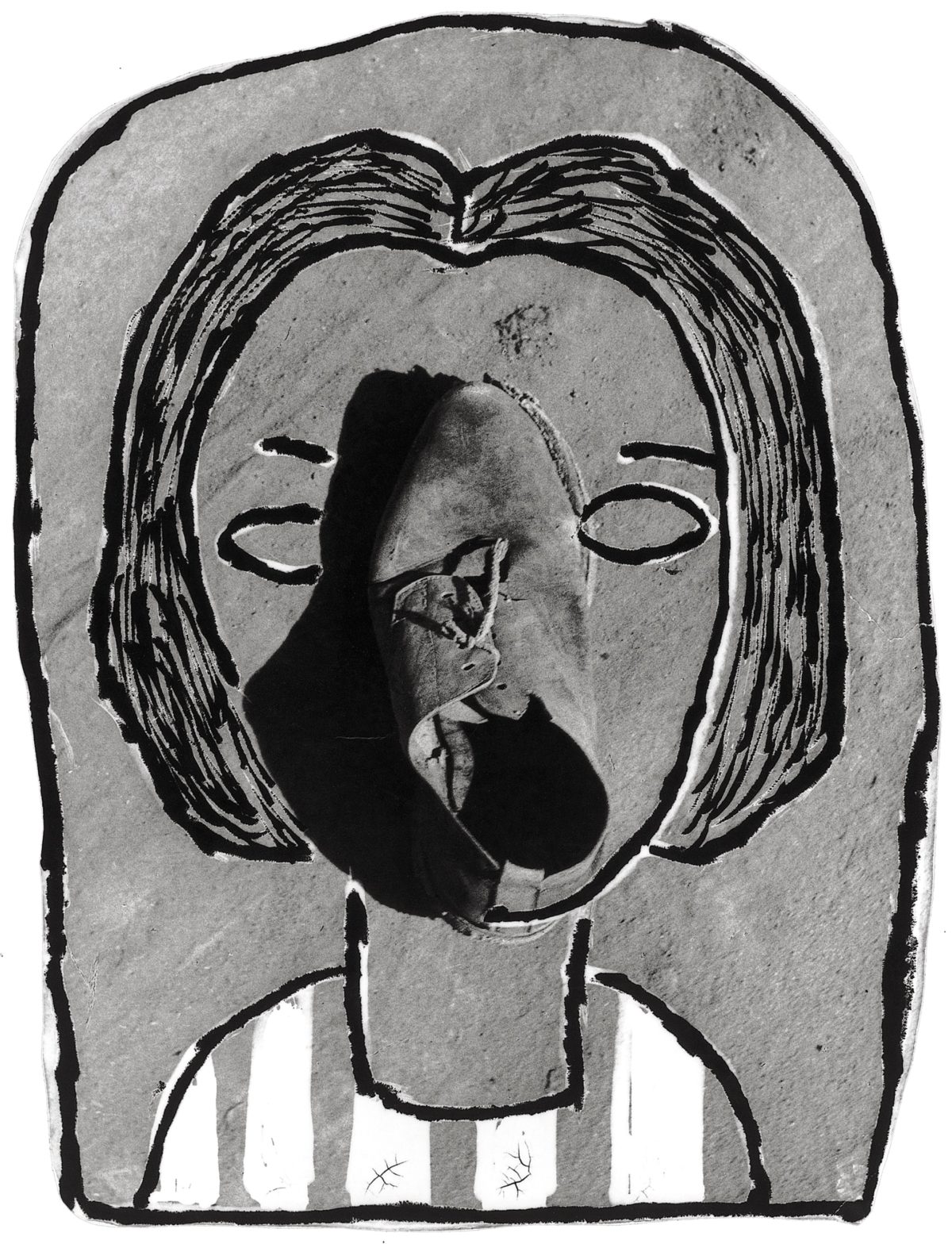
The works Barros presented in Fotoforma in 1951, as well as his Concrete paintings, which he began in 1952, drew on Pedrosa’s theories of the Gestalt, breaking with the traditional separation of figure and background to implicate the viewer in a dynamic perception of forms. In A Menina do Sapato (Girl with a Shoe, c. 1949), for example, the artist used drypoint instruments and india ink to draw on 2 3/8 by 2 3/8–inch negatives. The girl’s face emerges with the meeting of the photographed figure and the drawing etched onto on the negative’s surface. In lieu of a mouth and nose, there is an image of a tattered shoe. It is noteworthy that A Menina do Sapato, currently presented as a two-dimensional work, was shown in 1951 as a photo-object with an irregular format. For Fotoforma, it was glued to a rigid support with a three-dimensional base and, like a small sculpture, exhibited on a pedestal.
The process of scratching negatives was at the heart of Barros’s dispute with fellow FCCB members. Barros would later say that his work had been rejected and that he was regarded by his FCCB peers as “mad.”11Museu da Imagem e do Som de São Paulo, Secretaria do Estado da Cultura, Depoimento de Geraldo de Barros. Memória da Fotografia Project, August 17, 1994. Video: 100 minutes; Barros, interview with Herkenhoff. Eduardo Salvatore and German Lorca confirmed that Barros’s photos had led to “heated”12Eduardo Salvatore, interview with author, São Paulo, October 22, 2004 and “lively”13German Lorca, interview with author, São Paulo, December 16, 2004. discussions—and claimed that his experiments with cuts and scratches on the negative’s surface were unorthodox. According to Salvatore, “We thought this an undue intervention. . . . De Barros’s procedure was artificial and un-photographic.”14Salvatore, interview with the author. The Boletim Foto Cine never published his printed and cutout photographs, which suggests that these particular works were not part of the Bandeirante’s exhibition circuit.
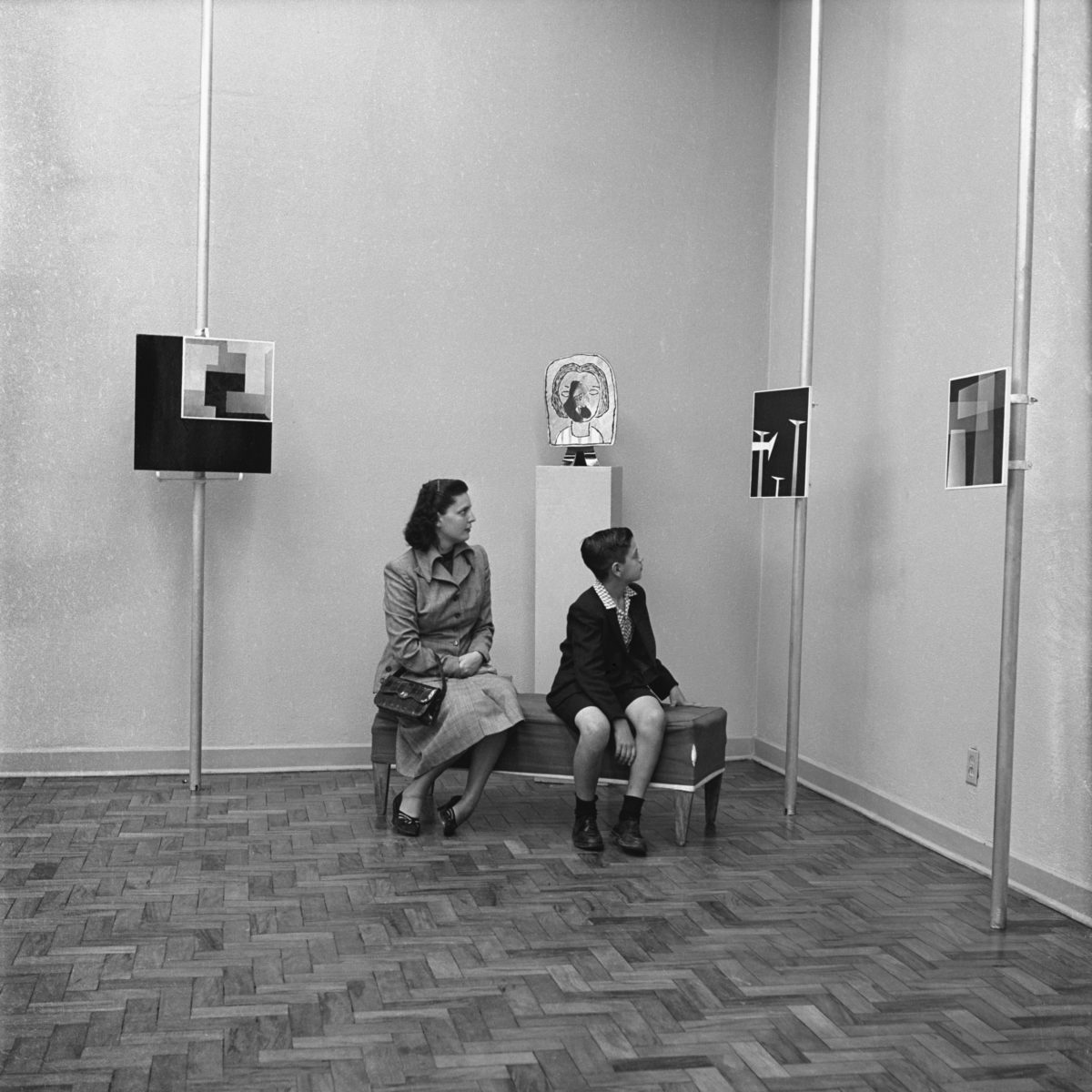
The works presented at MASP had been enlarged in the museum’s photo lab,15The principal source of information about Fotoforma is a set of fourteen documentary photographs, most of which were taken by Barros. The original works have either been lost or survive only as two-dimensional images, unmoored from the geometric panels designed at the time. which Geraldo de Barros and Thomaz Farkas had helped to set up during the institution’s 1950 renovation.16Barros, interview with Herkenhoff. Based on the geometry of everyday forms, Barros’s highly experimental work included geometric abstractions built from multiple exposures of a single negative; scribbles, scratches, and drawings on film; images produced with small fragments of negatives mounted on glass plates; self-portraits; photograms; and a few conventional photographs of vases and windows. Additionally, several photographs were made from the serial register of a single subject or based on the enlargement of various cutouts of a single negative. Such is the case of the images titled Fotoformas, Estação da Luz (fig. 5), which were shot at a train station in São Paulo’s city center. Until that moment, experiments with multiple exposures and mounted negatives had never been displayed within the context of the FCCB.
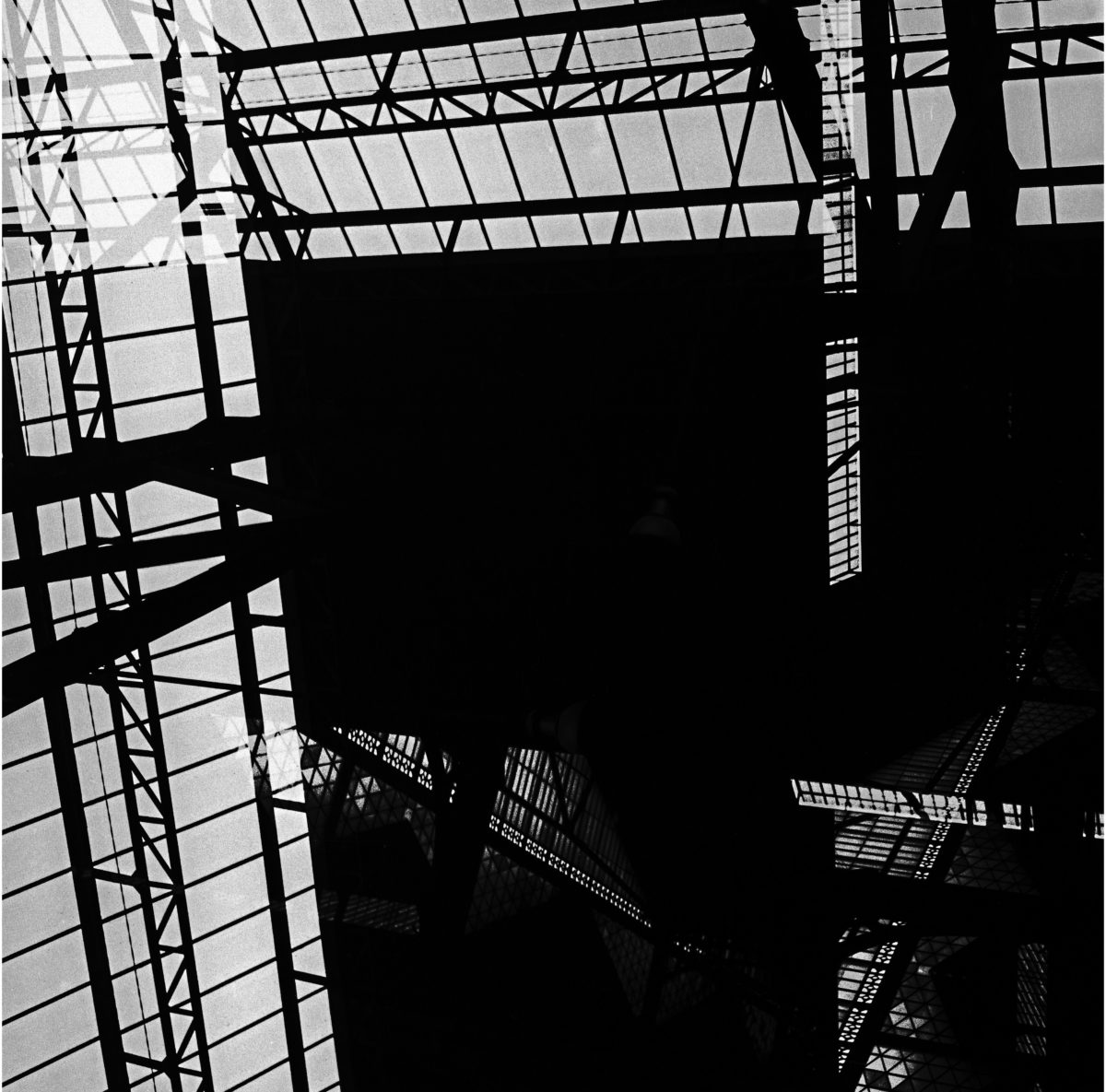
The powerful presence of geometry and the use of montage evince Geraldo de Barros’s interest in constructivist art. Beyond this, Fotoforma demonstrates the artist’s affinities with MASP’s program to break with the rigid hierarchy of fine and applied arts.17For more, see Heloisa Espada, “The Fotoforma Exhibition at MASP, 1951: Geraldo de Barros and the Museum-School,” in New Geographies of Abstract Art in Postwar Latin America, eds. Mariola V. Alvarez and Ana M. Franco (New York: Routledge, 2019), 69–83. To this effect, some photographs were directly affixed to metal tubes that stood close to the walls or hung loosely in space (figs. 1, 4). Others were presented on large geometric panels designed by Barros. These were made up of empty areas, rectangles, and lines (fig. 6). There were also the previously mentioned photographs cut into irregular formats, which were supported on small pedestals as if they were sculptures.
The floor-to-ceiling aluminum cylinders had been designed by Lina Bo Bardi (1914–1992) as supports for MASP’s collection in 1947, when the museum was established in temporary offices on the second floor of its headquarters in the Diários Associados building in downtown São Paulo. In her design for the conversion of the building into a museum, Bo Bardi reformulated the permanent collection display, at which point the previously used cylinders became temporary exhibition furniture.18Ricardo Resende, “MAM, o museu romântico de Lina Bo Bardi: origens e transformações de uma certa museografia. São Paulo” (master’s thesis, Universidade de São Paulo, 2002).
The white frames designed by Barros were similar to the frames used for MASP’s Le Corbusier retrospective Mundo Novo no Espaço (New World in Space) in 1950.19According to German Lorca, he and Barros photographed the show at the museum’s request. This information is confirmed in P. M. Bardi, Art Treasures of the São Paulo Museum and the Development of Art in Brazil (New York: Abrams, 1956). In addition, the masthead of the magazine Habitat 1 (October–December 1950), published by MASP, also confirms that Geraldo de Barros rendered photographic services to the museum. However, considering his participation in local constructivist art groups in São Paulo and Rio de Janeiro, it is more likely that Barros was inspired by El Lissitzky’s exhibition design projects of the 1920s. The Fotoforma panels were fashioned in such a way that when individual photographs were affixed to them, they became part of a larger geometric composition—in effect losing their autonomy. In one of the panels (fig. 6), a range of photographs—of a vase of flowers, the shadow of a chair, a perforated wall, and a kettle—has been incorporated into a geometric whole that surmounts each individual image. In other instances, a large, shiny black rectangle exceeds its function as a support to the photographic image (fig. 7), in fact becoming integral to it.
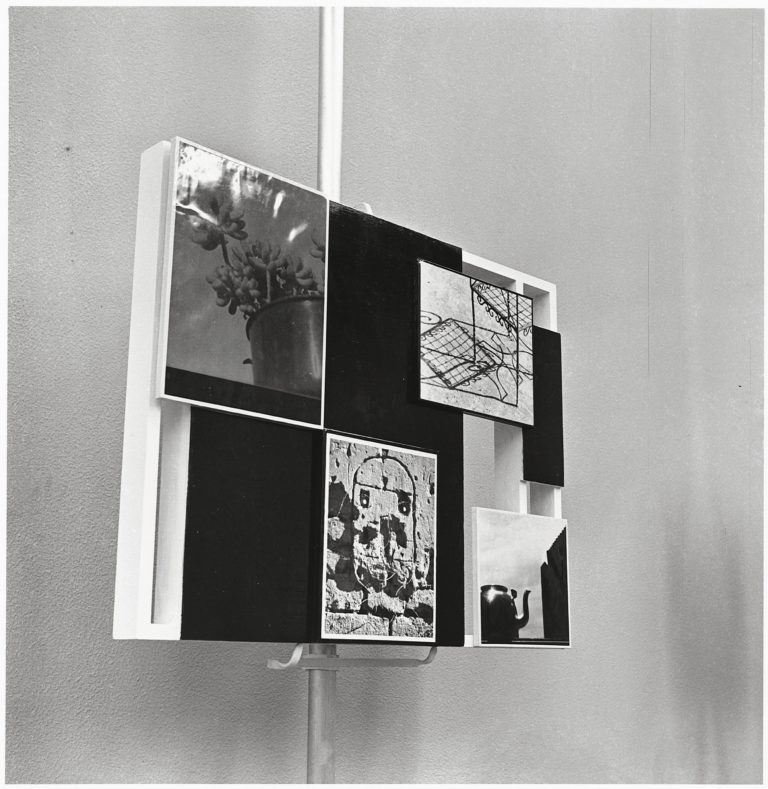
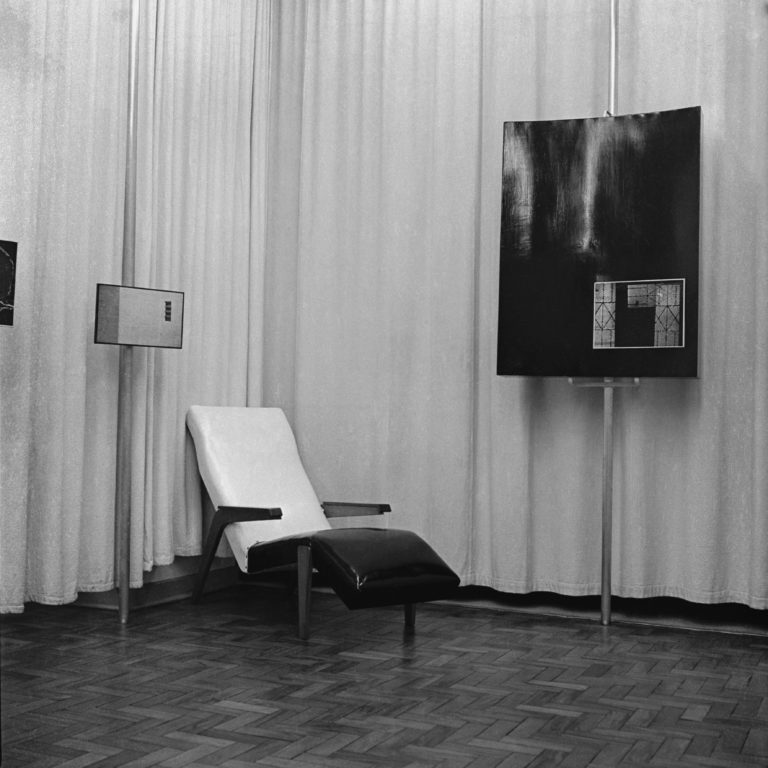
The exhibition also contained one of the transparent panels designed by Bo Bardi for MASP’s didactic exhibitions on art history (fig. 8). This structure bore the wall text, which was written by curator Pietro Maria Bardi, a portrait of Barros by Francisco Albuquerque, and a photograph from Barros’s Fotoforma series. Together, these elements also formed a composition. Barros took advantage of the panel’s transparency in order to make the three rectangles (the portrait, Fotoforma, and page with text) float, replicating the rotational movement that characterizes a fair number of his abstract photographs, including the Fotoforma that was part of this set. This particular Fotoforma forms part of the series made by juxtaposing backlit geometric forms (fig. 9). For the image in question (c. 1950), Barros photographed the same scene four times: a doorway in strong backlight. He turned and slightly displaced his Rolleiflex camera with each shot so as to vary the subject’s size and position within the frame. The action results in a composition of transparent quadrilaterals that are juxtaposed to create, by way of the layering of light, new geometric forms in tones of gray. The abstract Fotoformas made from the juxtaposition of geometric forms possess formal and conceptual affinities with Concrete art. They presuppose abstraction from recorded subjects, as well as previous conceptions of mental images, and their mechanical register.
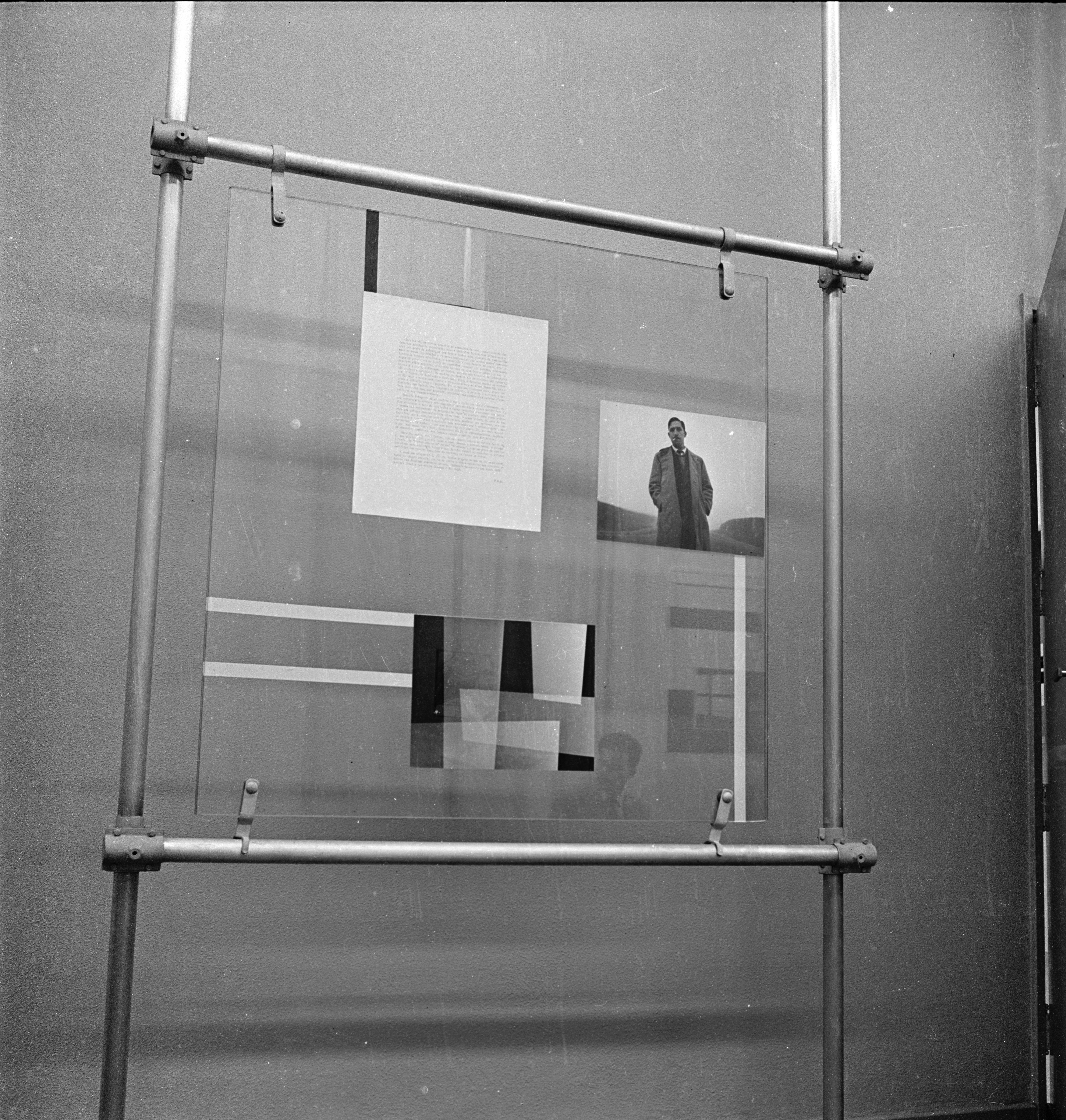
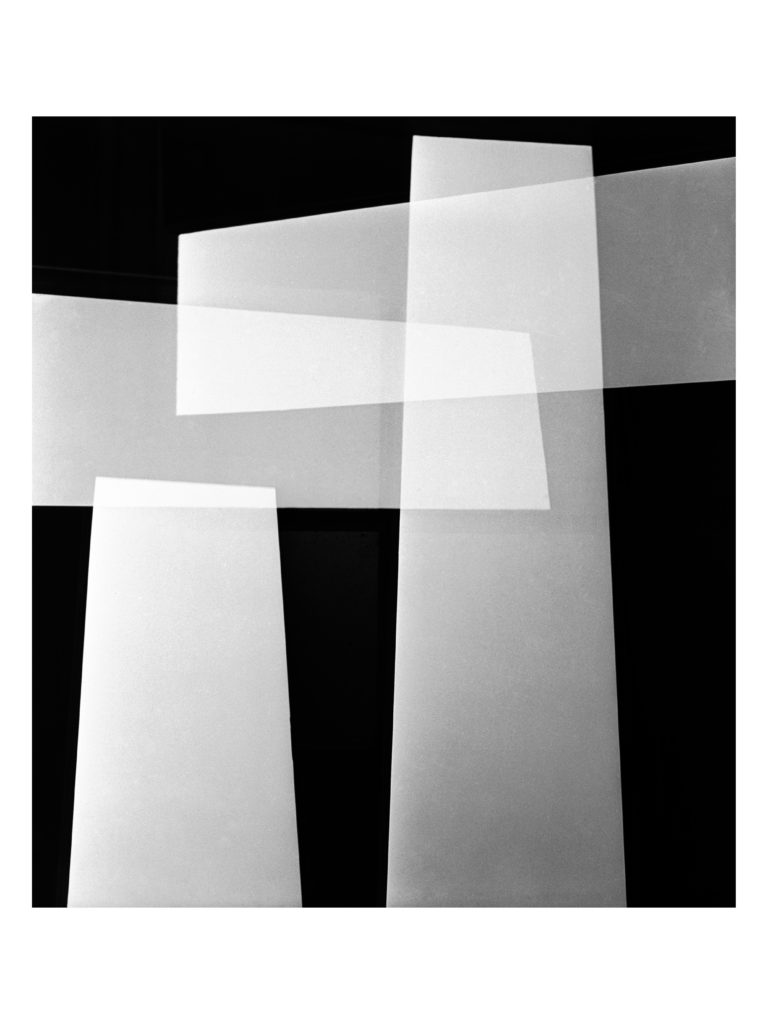
During 1951, Geraldo de Barros’s contact with the FCCB appears to have been slight, if not strictly perfunctory. The month following the closing of his exhibition, the artist left for a yearlong sojourn in Europe on a scholarship from the French government to study painting and printing at the École Nationale Supérieur des Beaux-arts in Paris. Until November of that year, he was listed as “international correspondent” on the Boletim’s masthead. Upon his return in 1952, he dedicated himself to Concrete painting, and from 1954, to furniture design—initially at the Unilabor work cooperative,20For more on Unilabor, see Mauro Claro, Unilabor: desenho industrial, arte moderna e autogestão operária (São Paulo: Editora Senac, 2004). and then, from 1964, at the helm of the Hobjeto factory. In an interview with Paulo Herkenhoff, he recalled his last work of 1953: photograms for the photography room at the second Bienal, most of which have been lost.21Barros, interview with Herkenhoff. There is still a small set of geometric photographs taken of the Unilabor chairs in 1954. It would seem that Barros’s most intense period of photographic work took place prior to his exhibition at MASP.
Barros relationship with the FCCB appears to have been somewhat agonistic. On the one hand, he continued to participate in salons promoted by the FCCB until 1954,22The exhibition catalogues reveal that Barros participated in the 1950, 1952, 1953, and 1954 editions. in addition to exhibiting photos as a Bandeirante member in other exhibitions in and outside of Brazil. On the other hand, according to the Boletim, he ceased to be an active member as of 1950. Barros recounts that fellow Bandeirante members considered him “novíssimo,” or novice in their ranking of prizes and exhibition participations.23Barros, interview with Herkenhoff. According to Marly Terezinha Castro Porto, Geraldo de Barros was not among the FCCB members who stood out in the Salões Internacionais de Arte Fotográfica from 1942 to 1959. Active FCCB members included Jacob Polacow (1913–1966), German Lorca, Marcel Giró (1912–2011), Gaspar Gasparian (1899–1966), José Oiticica Filho (1906–1964), Thomaz Farkas, José Yalente (1895–1967), and Eduardo Salvatore. See Marly T. C. Porto, “Confrontos e paralelos: o Salão Internacional de Arte Fotográfica de São Paulo (1942–1959)–Volume I” (master’s thesis, Universidade de São Paulo, 2018), 98–99. It is interesting to note that the Boletim did not publish an abstract Fotoforma until 1954.24Boletim Foto Cine 87 (February–March 1954): 10.
The trajectory of some FCCB’s members, such as that of Geraldo de Barros, exceeds in many ways the club’s aesthetic goals. Not only one of the earliest exhibitions of photography in a Brazilian museum, Fotoforma is also a landmark exhibition in the history of Brazilian abstraction. In sum, the large number of Geraldo de Barros’s photographic experiments presented on the occasion were not a consequence of Foto Cine Clube Bandeirante’s internal discussions and movements toward modern art, but rather tied to Grupo Ruptura’s concerns, Mário Pedrosa’s theories, and MASP’s interest in questioning the boundaries between art and design. From 1949 to 1950, when Barros was active in the club, none of these topics were discussed within its context. Geraldo de Barros wanted his photographs to circulate within their network, but his aesthetic experiments in photography were formulated outside of this environment.
You can read the first essay in the series here.
- 1Heloisa Espada’s essay revisits content published on previous occasions, including, most importantly, Heloisa Espada, “Fotoformas: a máquina lúdica de Geraldo de Barros” (master’ thesis, Universidade de São Paulo with funding provided by the Fundação de Amparo à Pesquisa do Estado de São Paulo [FAPESP], 2007; and Heloisa Espada, ed., Geraldo de Barros e a Fotografia (São Paulo: Instituto Moreira Salles, 2014).
- 2Argentinean amateur Humberto F. Zappa’s exhibition of forty-two bromoils opened on December 18, 1950. That month, the Boletim Foto Cine ran Zappa’s photo Amanhecer on its cover as well as his text “Apologia do bromólio” and a note on the exhibition inside. See: Boletim Foto Cine 56 (December 1950): 6–7, 14.
- 3“Exposição Thomaz J. Farkas,” Boletim Foto Cine 39 (July 1949): 14.
- 4“Exposição G. Lorca,” Boletim Foto Cine 74 (July 1952): 30; “Exposição de Francisco Albuquerque ‘A jangada,’” Boletim Foto Cine 78 (1952): 24.
- 5“Exposição de Fotografias de Ademar Manarini,” Boletim Foto Cine 91 (August 1954): 13–16.
- 6Geraldo de Barros, “A sala de fotografia,” Boletim Foto Cine 87 (February 1954): 12–13.
- 7MAM/SP disconnected from organization of the Bienal in 1962, and the event was renamed the Bienal Internacional de São Paulo, as it is known today.
- 8Jorge Vasconcelos, “Itinerários (Geraldo de Barros),” Diário de São Paulo, July 14, 1979; Walter Zanini, “Geraldo de Barros: Jovem Pesquisador, corpo e alma integrados na formulação da arte viva: de Klee à pintura concreta. Impressões ligeiras de sua viagem à Europa,” O Tempo, March 8, 1953; Geraldo de Barros, interview by Paulo Herkenhoff, April 19, 1988, transcript, Museu de Arte Moderna do Rio de Janeiro’s library documents collection.
- 9Grupo Ruptura was formed by Geraldo de Barros, Waldemar Cordeiro (1925–1972), Lothar Charoux (1912–1927), Kazmer Fejér (1923–1989), Anatol Wladyslaw (1913–2004), Luiz Sacilotto (1924–2003), and Leopoldo Haar (1910–1954).
- 10Mário Pedrosa, “Arte, necessidade vital,” in Forma e Percepção Estética: Textos Escolhidos II, ed. Otília Arantes (São Paulo: Editora da Universidade de São Paulo, 1996), 41–56.
- 11Museu da Imagem e do Som de São Paulo, Secretaria do Estado da Cultura, Depoimento de Geraldo de Barros. Memória da Fotografia Project, August 17, 1994. Video: 100 minutes; Barros, interview with Herkenhoff.
- 12Eduardo Salvatore, interview with author, São Paulo, October 22, 2004
- 13German Lorca, interview with author, São Paulo, December 16, 2004.
- 14Salvatore, interview with the author.
- 15The principal source of information about Fotoforma is a set of fourteen documentary photographs, most of which were taken by Barros. The original works have either been lost or survive only as two-dimensional images, unmoored from the geometric panels designed at the time.
- 16Barros, interview with Herkenhoff.
- 17For more, see Heloisa Espada, “The Fotoforma Exhibition at MASP, 1951: Geraldo de Barros and the Museum-School,” in New Geographies of Abstract Art in Postwar Latin America, eds. Mariola V. Alvarez and Ana M. Franco (New York: Routledge, 2019), 69–83.
- 18Ricardo Resende, “MAM, o museu romântico de Lina Bo Bardi: origens e transformações de uma certa museografia. São Paulo” (master’s thesis, Universidade de São Paulo, 2002).
- 19According to German Lorca, he and Barros photographed the show at the museum’s request. This information is confirmed in P. M. Bardi, Art Treasures of the São Paulo Museum and the Development of Art in Brazil (New York: Abrams, 1956). In addition, the masthead of the magazine Habitat 1 (October–December 1950), published by MASP, also confirms that Geraldo de Barros rendered photographic services to the museum.
- 20For more on Unilabor, see Mauro Claro, Unilabor: desenho industrial, arte moderna e autogestão operária (São Paulo: Editora Senac, 2004).
- 21Barros, interview with Herkenhoff.
- 22The exhibition catalogues reveal that Barros participated in the 1950, 1952, 1953, and 1954 editions.
- 23Barros, interview with Herkenhoff. According to Marly Terezinha Castro Porto, Geraldo de Barros was not among the FCCB members who stood out in the Salões Internacionais de Arte Fotográfica from 1942 to 1959. Active FCCB members included Jacob Polacow (1913–1966), German Lorca, Marcel Giró (1912–2011), Gaspar Gasparian (1899–1966), José Oiticica Filho (1906–1964), Thomaz Farkas, José Yalente (1895–1967), and Eduardo Salvatore. See Marly T. C. Porto, “Confrontos e paralelos: o Salão Internacional de Arte Fotográfica de São Paulo (1942–1959)–Volume I” (master’s thesis, Universidade de São Paulo, 2018), 98–99.
- 24Boletim Foto Cine 87 (February–March 1954): 10.
